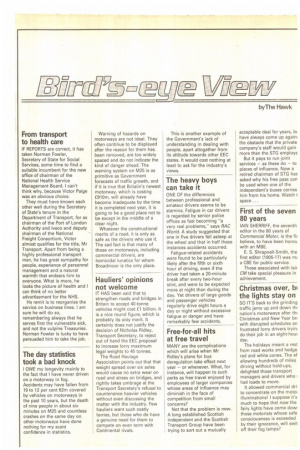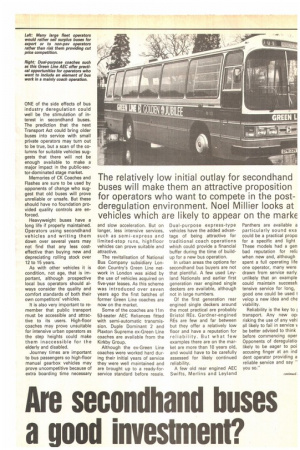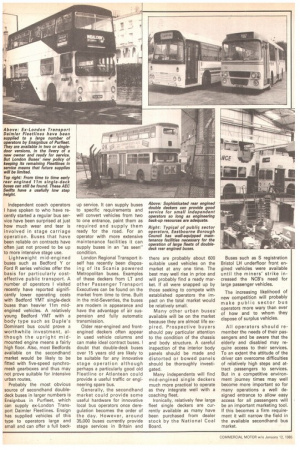Lthtftof ) Via gof
Page 31

Page 33

Page 34

If you've noticed an error in this article please click here to report it so we can fix it.
byThe Hawk From transport to health care
IF REPORTS are correct, it has taken Norman Fowler, Secretary of State for Social Services, some time to find a suitable incumbent for the new office of chairman of the National Health Service Management Board. I can't think why, because Victor Paige was an obvious choice.
They must have known each other well during the Secretary of State's tenure in the Department of Transport, for as chairman of the Port of London Authority and Iveco and deputy chairman of the National • Freight Consortium, Victor almost qualifies for the title, Mr Transport. Apart from being a highly professional transport man, he has great sympathy for people, experience of personnel management and a natural warmth that endears him to everyone. What is more, he looks the picture of health and I can think of no better advertisement for the NHS.
He remit is to reorganise the service on business lines. I am sure he will do so, remembering always that he serves first the vulnerable sick, and not the vulpine Treasuries. Norman Fowler is lucky to have persuaded him to take the job.
The day statistics took a bad knock
I OWE my longevity mainly to the fact that I have never driven on a motorway in fog. Accidents may have fallen from 19 to 12 per cent 62m covered by vehicles on motorways in the past 10 years, but the death of nine people in about six minutes on M25 and countless crashes on the same day on other motorways have done nothing for my scant confidence in statistics. Warning of hazards on motorways are not ideal. They often continue to be displayed after the reason for them has been removed, are too widely spaced and do not indicate the kind of danger ahead. The warning system on M25 is as primitive as Government forecasts of traffic growth, and if it is true that Britaiin's newest motorway, which is costing £910m, will already have become inadequate by the time it is completed next year, it is going to be a good place not to be except in the middle of a clear night.
Whatever the constructional merits of a road, it is only as safe as the drivers who use it. The sad fact is that many of those on motorways, including commercial drivers, are homicidal lunatics for whom Broadmoor is the only place.
Hauliers' opinions not welcome
IT HAS been said that to strengthen roads and bridges in Britain to accept 40-tonne vehicles might cost E1 billion. It is a nice round figure, which is probably its only merit. It certainly does not justify the decision of Nicholas Ridley, Transport Secretary, to reject out of hand the EEC proposal to increase lorry maximum legal weights to 40 tonnes.
The Road Haulage Association points out that that weight spread over six axles would cause no extra wear on road and stress on bridges, and rightly takes umbrage at the Transport Secretary's refusal to countenance heavier vehicles without even discussing the matter with the industry. Few hauliers want such costly lorries, but those who do have a genuine need for them to compete on even term with Continental rivals. This is another example of the Government's lack of understanding in dealing with people, apart altogether from its attitude towards other EEC states. It would cost nothing at least to ask for the industry's views.
The heavy boys can take it
ONE OF the differences between professional and amateur drivers seems to be stamina. Fatigue in car drivers is regarded by senior police offices as fast becoming "a very real problems," says RAC World. A study suggested that one in five drivers fell asleep at the wheel and that in half these instances accidents occurred.
Fatigue-related accidents were found to be particularly likely after the fifth or sixth hour of driving, even if the driver had taken a 20-minute break after every two-hour stint, and were to be expected more at night than during the day. Yet drivers of large goods and passenger vehicles regularly drive eight hours a day or night without excessive fatigue or danger and have remarkably few accidents.
Free-for-all hits at free travel
MANY are the complications which will arise when Mr Ridley's plans for bus deregulation take effect next year — or whenever. What, for instance, will happen to such perks as free travel enjoyed by employees of larger companies whose areas of influence may diminish in the face of competition from small concerns?
Not that the problem is new. A long established Scottish independent and the Scottish Transport Group have been trying to sort out a mutually
acceptable deal for years, bt have always come up again: the obstacle that the private company's staff would gain more than the STG employ€ But it pays to run joint services — as these do — to places of influence. Now a retired chairman of STG has asked why his free pass can be used when one of the independent's buses carries him from his home. Watch i space ...
First of the seven 80 years
IAIN SHERRIFF, the seventh editor in the 80 years of Commercial Motor, is the fil believe, to have been honot with an MBE.
E. S. Shrapnell-Smith, the first editor (1905-17) was mi a CBE for public service.
Those associated with lair CM take special pleasure in achievement.
Christmas over, bi the lights stay on
SO IT'S back to the grinding traffic jams up and down thi nation's motorways after thi Christmas and New Year bri with disrupted schedules an frustrated lorry drivers tryini do their job in an eight-houi day.
The holidays meant a rest from road works and hedge red and white cones. The ef allowing hundreds of miles driving without hold-ups, delighted those transport managers and drivers who had loads to move.
It allowed commercial dri' to concentrate on the motoi illuminations! I suppose it's much to hope that now the fairy lights have come dowi those motorists whose safe consciousness is exceeded by their ignorance, will swit off their fog lamps? ONE of the side effects of bus industry deregulation could well be the stimulation of interest in secondhand buses. The prediction that the next Transport Act could bring older buses into service with small private operators may turn out to be true, but a scan of the columns for suitable vehicles suggests that there will riot be enough available to make a major impact in the public-sector-dominated stage market.
Memories of CK Coaches and Flashes are sure to be used by opponents of change who suggest that old buses will prove unreliable or unsafe. But these should have no foundation provided quality controls are enforced.
Heavyweight buses have a long life if properly maintained. Operators using secondhand vehicles and writing them down over several years may not find that any less costeffective than buying new and depreciating rolling stock over 12 to 15 years.
As with other vehicles it is condition, not age, that is important, although prospective local bus operators should always consider the quality and comfort standards of both their own competitors' vehicles.
It is also very important to remember that public transport must be accessible and attractive to its users. High-floor coaches may prove unsuitable for intensive urban operators as the step heights could make them inaccessible for the elderly and disabled.
Journey times are important to bus passengers so high-floor manual gearbox vehicles may prove uncompetitive because of extra boarding time necessary and slow acceleration. But on longer, less intensive services, such as semi-express and limited-stop runs, highfloor vehicles can prove suitable and attractive.
The revitalisation of National Bus Company subsidiary London Country's Green Line network in London was aided by the use of vehicles acquired on five-year leases. As this scheme was introduced over seven years ago the first batches of former Green Line coaches are now on the market.
Some of the coaches are llm 53-seater AEC Reliances fitted with semi-automatic transmission. Duple Dominant 2 and Plaxton Supreme ex-Green Line coaches are available from the Kirkby Group.
Although the ex-Green Line coaches were worked hard during their initial years of service they were well maintained and are brought up to a ready-forservice standard before resale. Dual-purpose express-type vehicles have the added advantage of being attractive for traditional coach operations which could provide a financial buffer during the time of buildup for a new bus operation.
In urban areas the options for secondhand bus buyers are not that plentiful. A few used Leyland Nationals and earlier first generation rear engined single deckers are available, although not in large numbers.
Of the first generation rear engined single deckers around the most practical are probably Bristol REs. Gardner-engined REs are few and far between but they offer a relatively low floor and have a reputation for reliability. But what few examples there are on the market are more than 10 years old, and would have to be carefully assessed for likely continued reliability.
A few old rear engined AEC Swifts, Merlins and Leyland Panthers are available a particularly sound exa could be a practical propo for a specific and light These models had a gen bad reputation for reN when new and, although spent a full operating life one operator, many were drawn from service early unlikely that an example could maintain successfk tensive service for long, good one could be used 1 velop a new idea and che viability.
Reliability is the key to I transport. Any new opl risking the use of any vehi all likely to fail in service u be better advised to think before commencing oper Opponents of deregulatio likely to be eager to poi accusing finger at an ind dent operator providing a reliable service and say " you so." Independent coach operators I have spoken to who have recently started a regular bus service have been surprised at just how much wear and tear is involved in stage carriage operation. Buses that have been reliable on contracts have often just not proved to be up to more intensive stage use.
Lightweight mid-engined buses such as Bedford V or Ford R series vehicles offer the basis for particularly costeffective public transport. A number of operators I visited recently have reported significantly lower operating costs with Bedford '(MT single-deck buses than heavier 11rn midengined vehicles. A relatively young Bedford '(MT with a body type such as Duple's Dominant bus could prove a worthwhile investment, although the upright midmounted engine means a fairly high floor. Also, most Bedfords available on the secondhand market would be likely to be fitted with five-speed synchromesh gearboxes and thus may not prove suitable for intensive urban routes.
Probably the most obvious source of secondhand doubledeck buses in larger numbers is Ensignbus in Purfleet, which can supply ex-London Transport Daimler Fleetlines. Ensign has supplied vehicles of this type to operators large and small and can offer a full back
up service. It can supply buses to specific requirements and will convert vehicles from two to one entrance, paint them as required and supply them ready for the road. For an operator with more extensive maintenance facilities it can supply buses in an "as seen" condition.
London Regional Transport itself has recently been disposing of its Scania powered Metropolitan buses. Examples of these deckers from LT and other Passenger Transport Executives can be found on the market from time to time. Built in the mid-Seventies, the buses are modern in appearance and have the advantage of 'air suspension and fully automatic transmission.
Older rear-engined and frontengined deckers often appear in used vehicle columns and can make ideal contract buses. I doubt that double-deck buses over 15 years old are likely to be suitable for any innovative stage operation although perhaps a particularly good old Fleetline or Atlantean could provide a useful traffic or engineering spare bus.
Generally, the secondhand market could provide some useful hardware for innovative local bus operators once deregulation becomes the order of the day. However, around 35,000 buses currently provide stage services in Britain and there are probably about 600 suitable used vehicles on the market at any one time. The best may well rise in price and will probably find a ready market. If all were snapped up by those seeking to compete with established operators the impact on the total market would be relatively small.
Many other urban buses' available will be on the market because they are almost life expired. Prospective buyers should pay particular attention to the condition of the chassis and body structure. A careful inspection of the interior body panels should be made and distorted or bowed panels should be thoroughly investigated.
Many independents will find mid-engined single deckers much more practical to operate as they integrate well with a coaching fleet.
Ironically, relatively few large fleet single deckers are currently available as many have been purchased from dealer stock by the National Coal Board. Buses such as S registration Bristol LH underfloor front engined vehicles were available until the miners' strike increased the NCB's need for large passenger vehicles.
The increasing likelihood of new competition will probably make public sector bus operators more wary than ever of how and to whom they dispose of surplus vehicles.
All operators should remember the needs of their passengers and be aware that the elderly and disabled may require access to their services. To an extent the attitude of the driver can overcome difficulties of relatively high steps and attract passengers to services. But in a competitive environment journey times may well become more important so for many operations a well designed entrance to allow easy access for all passengers will be an important marketing tool. If this becomes a firm requirement it will narrow the field in the available secondhand bus market.
























































































